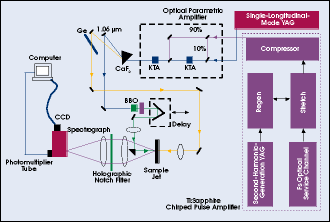
Spectroscopy Tracks Vibrational Energy in Liquids
Kevin Robinson
Using ultrafast anti-Stokes Raman spectroscopy, chemists at the University of Illinois in Urbana-Champaign have developed a spectroscopic method for tracking the flow of vibrational energy through the chemical bonds of molecules in the liquid state. The technique enables them to explore a fundamental chemical process that has remained relatively elusive.

Researchers at the University of Illinois are using a pump-and-probe technique called three-dimensional vibrational spectroscopy to monitor vibrational energy transfer within a liquid-phase molecule. The experimental setup is shown. Courtesy of Dana D. Dlott.
All molecules have quantized vibrational states that are related to their number of atoms. Vibrational energy is the oscillation of these atoms with respect to their chemical bonds, which provide a spectral fingerprint that researchers can use to identify a molecule or to characterize its dynamic motion. In Raman spectroscopy, a small portion of the laser radiation that strikes a molecule scatters and is red- or blue-shifted by an amount equal to a vibrational quantum of energy.
These shifts differ in a crucial way. The red-shifted Stokes scattering occurs whether or not the molecular vibrations are excited, but the blue-shifted anti-Stokes scattering is only observed from vibrations in excited states. Specifically, in anti-Stokes, the excited molecule loses some of its vibrational energy in the form of photons with higher energy than the incoming ones, and the intensity of the shift is directly related to the amount of energy in that particular vibrational state.
To take advantage of this process in a liquid-phase molecule, professor Dana D. Dlott and postdoctoral research assistants Zhaohui Wang and Andrei Pakoulev excite a sample's known vibration levels with a 600-fs pulse from a tunable infrared laser. Shortly thereafter, they illuminate it with a 700-fs, visible-wavelength probe pulse. By watching the changes in the intensities of a particular anti-Stokes shift, they can determine how the vibrational energy flows from one end of the molecule to the other and into the surrounding liquid. They call the technique three-dimensional vibrational spectroscopy because it measures the vibrational frequency excited by the infrared pulse and probed by anti-Stokes scattering, and the time delay between excitation and probing.
Probing alcohol
The new feature of this work is the ability to observe the vibrational energy flow. To demonstrate this, the researchers applied the technique to various alcohols. Dlott said that they chose alcohols because they are inexpensive, are relatively nontoxic and have different chemical structures on each end that are easily distinguished by their Raman spectra.
Each of the alcohol molecules, such as butanol (OH-CH2-CH2-CH2-CH3), has an alcohol combination on one end and a terminal methyl configuration on the other end. The researchers excited just the OH bond and determined how that vibrational energy was transferred through the intermediate methylene groups to the terminal methyl. They found that each additional CH2 in the chain increased the time of energy transfer by approximately 400 fs.
Dlott said that they are working to adapt the technique for studying molecules at low temperature and for studying biological molecules. He added that they do not yet know if some chemical bonds are better than others at transmitting vibrational energy, but they have a clue. In their experiments, only about 1 percent of the vibrational energy at the OH group ever made it to the methyl group at the end.
Published: September 2002